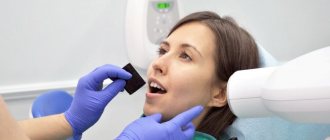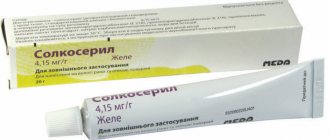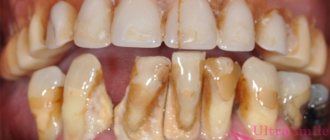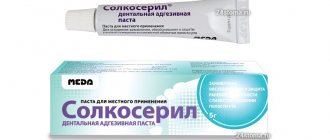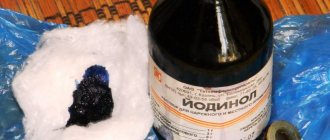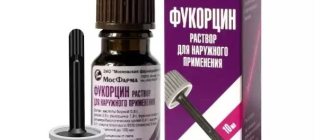Description
Capsule-shaped tablets, with a biconvex surface, film-coated, white or almost white. White in cross section.
Pharmacotherapeutic group
Antimicrobial drugs are quinolone derivatives. Fluoroquinolones.
ATS code
J01MA02
Pharmacological properties
Pharmacokinetics
When taken orally, it is quickly and fairly completely absorbed from the gastrointestinal tract (mainly in the duodenum and jejunum). Eating slows down absorption but does not change maximum concentration (Cmax) or bioavailability. Bioavailability - 50-85%, volume of distribution - 2-3.5 l/kg, binding to plasma proteins - 20-40%. The time to reach the maximum concentration (TCmax) is 60-90 minutes, the maximum concentration linearly depends on the dose taken and is 1.2, 2.4, 4.3 and 5.4 μg/ml at doses of 250, 500, 750 and 1000 mg, respectively. 12 hours after oral administration of 250, 500 and 750 mg, the concentration of the drug in plasma decreases to 0.1, 0.2 and 0.4 mcg/ml, respectively.
Well distributed in body tissues (excluding fat-rich tissue, such as nervous tissue). The concentration in tissues is 2-12 times higher than in plasma. Therapeutic concentrations are achieved in saliva, tonsils, liver, gallbladder, bile, intestines, abdominal and pelvic organs (endometrium, fallopian tubes and ovaries, uterus), seminal fluid, prostate tissue, kidneys and urinary tract, pulmonary tissue, bronchial secretions, bone tissue, muscles, synovial fluid and articular cartilage, peritoneal fluid, skin. It penetrates into the cerebrospinal fluid in a small amount, where its concentration in the absence of inflammation of the meninges is 6-10% of that in the blood serum, and in the case of inflammation - 14-37%. Ciprofloxacin also penetrates well into the ocular fluid, pleura, peritoneum, lymph, and through the placenta. The concentration of ciprofloxacin in blood neutrophils is 2-7 times higher than in blood serum.
Metabolized in the liver (15-30%) with the formation of low-active metabolites (diethylciprofloxacin, sulfociprofloxacin, oxociprofloxacin, formylciprofloxacin).
The half-life is about 4 hours, in case of chronic renal failure - up to 12 hours. It is excreted mainly by the kidneys by tubular filtration and tubular secretion in unchanged form (40-50%) and in the form of metabolites (15%), the rest - through the gastrointestinal tract. intestinal tract. A small amount is excreted in breast milk.
Renal clearance - 3-5 ml/min/kg; total clearance - 8-10 ml/min/kg.
In chronic renal failure (creatinine clearance above 20 ml/min), the percentage of the drug excreted through the kidneys decreases, but accumulation in the body does not occur due to a compensatory increase in drug metabolism and excretion through the gastrointestinal tract.
Pharmacodynamics
A broad-spectrum antimicrobial agent, a quinolone derivative, suppresses bacterial DNA gyrase (topoisomerases II and IV, responsible for the process of supercoiling of chromosomal DNA around nuclear RNA, which is necessary for reading genetic information), disrupts DNA synthesis, growth and division of bacteria; causes pronounced morphological changes (including cell wall and membranes) and rapid death of the bacterial cell.
It has a bactericidal effect on gram-negative microorganisms during the period of rest and division (since it affects not only DNA gyrase, but also causes lysis of the cell wall), on gram-positive microorganisms - only during the period of division.
Low toxicity for the cells of the macroorganism is explained by the absence of DNA gyrase in them. While taking ciprofloxacin, there is no parallel development of resistance to antibacterial drugs that do not belong to the group of gyrase inhibitors, which makes it effective against bacteria that are resistant, for example, to aminoglycosides, penicillins, cephalosporins, tetracyclines.
Gram-negative aerobic bacteria are sensitive to ciprofloxacin: enterobacteria (Escherichia coli, Salmonella spp., Shigella spp., Citrobacter spp., Klebsiella spp., Enterobacter spp., Proteus mirabilis, Proteus vulgaris, Serratia marcescens, Hafnia alvei, Edwardsiella tarda, Providencia spp. , Morganella morganii, Vibrio spp., Yersinia spp.), other gram-negative bacteria (Haemophilus spp., Pseudomonas aeruginosa, Moraxella catarrhalis, Aeromonas spp., Pasteurella multocida, Plesiomonas shigelloides, Campylobacter jejuni, Neisseria spp.); some intracellular pathogens: Legionella pneumophila, Brucella spp., Listeria monocytogenes, Mycobacterium tuberculosis, Mycobacterium kansasii.
Gram-positive aerobic bacteria are also sensitive to ciprofloxacin: Staphylococcus spp. (Staphylococcus aureus, Staphylococcus haemolyticus, Staphylococcus hominis, Staphylococcus saprophyticus), Streptococcus spp. (Streptococcus pyogenes, Streptococcus agalactiae).
Active against Bacillus anthracis.
Most staphylococci resistant to methicillin are also resistant to ciprofloxacin. The sensitivity of Streptococcus pneumoniae, Enterococcus faecalis, Mycobacterium avium (located intracellularly) is moderate (high concentrations are required to suppress them).
The following are resistant to the drug: Bacteroides fragilis, Pseudomonas cepacia, Pseudomonas maltophilia, Ureaplasma urealyticum, Clostridium difficile, Nocardia asteroides. Not effective against Treponema pallidum.
Resistance develops extremely slowly, since, on the one hand, after the action of ciprofloxacin there are practically no persistent microorganisms left, and on the other hand, bacterial cells do not have enzymes that inactivate it.
The significance of the use of ciprofloxacin in clinical practice
One of the most striking and well-studied PCs is ciprofloxacin. All PCs have a bactericidal effect, which manifests itself at minimum inhibitory concentrations (MICs) or MICs exceeding no more than 2–4 times. Thus, it has been shown that for ciprofloxacin the MIC is 0.016–2 mg/l against P. Aeruginosa, however, there are pseudomonad strains that are resistant to ciprofloxacin - the MIC is from 8 to 32 mg/l, but ciprofloxacin still retains its advantages; Its activity against Legionella, Enterobacteriaceae, Y. Pestis should also be noted. Ciprofloxacin, like ofloxacin, demonstrates activity against gram-positive cocci [5]. PCs penetrate into the bacterial cell through the outer membrane: hydrophilic drugs penetrate through porin channels, through which, in addition to PCs, b-lactam ABs, tetracyclines, chloramphenicol, and aminoglycosides also penetrate. Hydrophobic PCs penetrate the polysaccharide layer. Thus, disruption of the permeability of, for example, porin channels will not affect permeability through the lipopolysaccharide layer. The process of PC removal from the cell is carried out by special carrier proteins [2]. PCs are DNA gyrase inhibitors. Blocking this enzyme leads to impaired division, bacteriostasis and rapid cell death. DNA gyrase belongs to the class of type II topoisomerases. Topoisomerases are found in both the cells of prokaryotes (bacteria) and eukaryotes (mammals), but this enzyme differs in structure and function in prokaryotes and eukaryotes; Thus, DNA gyrase is the main enzyme responsible for preparing DNA replication in the bacterial chromosome. These functions of DNA gyrase are characteristic only of bacteria; in mammals, a similar enzyme, topoisomerase II, does not catalyze DNA folding and is characterized by low sensitivity to PC, which explains the absence of toxic effects associated with impaired DNA biosynthesis. However, in the bacterial cell there is another target for PC – topoisomerase IV. Both enzymes (DNA gyrase and topoisomerase IV) are necessary for the synthesis of bacterial DNA, and it has been shown that in gram-negative bacteria the primary target is DNA gyrase, and in gram-positive bacteria topoisomerase is more sensitive to fluoroquinolones [5,11]. Thus, high intracellular concentrations and inhibition of target enzymes determine the high bactericidal activity of the drug. Antimicrobial activity. Ciprofloxacin is one of the most active against gram-negative aerobic bacteria (Campylobacter jejuni, Citrobacter diversus, Citrobacter freundii, Enterobacter cloacae, Escherichia coli, Haemophilus influenzae, Haemophilus parainfluenzae, Klebsiella pneumonia, Moraxella catarrhalis, Morganella morganii, Neisseria gonorrhoeae, Proteus mirabilis, Pro teus vulgaris, Providencia rettgeri, Pceudomonas aeruginosa, Salmonella, etc.), gram-positive asrobes (Bacillus anthracis, Enterococcus faecali (most strains are relatively sensitive), Lysteria monocitogenes, Staphylococcus aureus, Staphylococcus epiudermidis, Staphylococcus saprophyticus, Staphylococcus pneumoniae, Staphylococcus pyogens), anerobic gram-positive : Staphylococcus haemophilus, Staphylococcus hominis, anerobic gram-negative (Acinetobacter Iwoffi, Aeromonas caviae, Aeromonas hydrophilia, Brucella melitensis, Campylobacter coli, Edwadsiella tarda, Haemophilus ducreyi, Klebsiella oxytoca, Legionella pneumophila, Neisseria meningitides, etc.). Ciprofloxacin has a bactericidal effect not only on reproducing cells, but also on resting cells, which are characterized by the longest post-antibiotic effect. Ciprofloxacin demonstrates activity against organisms resistant to penicillins, cephalosporins and aminoglycosides, as well as against Haemophilus influenzae, penicillin-producing N. Gonorrhoa, Campilobacter sp., and pseudomonas. Gram-positive microorganisms, streptococci and pneumococci are weakly inhibited and demonstrate resistance; ciprofloxacin is not used in cases of methicillin-resistant staphylococcal infections [11]. It should be said that the nature of methicillin resistance has not been fully elucidated. The most likely and most proven cause is changes that occur in specific penicillin-binding proteins of the cell wall of staphylococci. Now there are new fluoroquinolones in the arsenal that are active against gram-positive cocci - moxifloxacin, gatifloxacin, clinafloxacin. These PCs demonstrate activity against ciprofloxacin-resistant Gram-positive bacteria that is much greater than that of vancomycin and ceftazidime. Pharmacokinetics. Ificipro®OD – long-acting ciprofloxacin – provides a long-lasting and uniform release of ciprofloxacin. A single dose of Ificipro®OD 0.5 g or 1.0 g provides a concentration of ciprofloxacin equivalent to a double dose of regular ciprofloxacin 250 mg or 500 mg, respectively. After oral administration, ciprofloxacin is rapidly absorbed from the gastrointestinal tract. Ificipro®OD 0.5 g tablets or Ificipro®OD 1.0 g tablets showed comparable rates and duration of absorption compared to immediate absorption of ciprofloxacin 250 mg and 500 mg tablets under the same study conditions. For ciprofloxacin - Ificipro®OD 0.5 g and Ificipro®OD 1.0 g after taking a single dose, peak plasma concentrations of the drug are reached within 6–7 hours and are 0.784 μg/ml and 1.393 μg/ml, respectively. The corresponding values of the area under the pharmacokinetic curve (AUC0–t) are 10.503 and 17.651 μg/h/ml. Binding to plasma proteins is from 20 to 40%. Ciprofloxacin penetrates well into tissues and fluids of the body (lungs, skin, adipose tissue, muscles, cartilage and bone tissue, prostate). In its active form, ciprofloxacin is found in saliva, secretions of the mucous membrane of the nasal cavity and bronchi, semen, lymph, peritoneal fluid and prostate secretions. Ciprofloxacin is partially metabolized in the liver. About 50% of the dose taken orally is excreted in the urine unchanged and about 15% as the active metabolite of oxociprofloxacin. Renal clearance for ciprofloxacin is almost 2 times higher than glomerular filtration, because the drug is actively eliminated by transporter proteins. The remainder of the incoming dose is excreted extrarenally - with bile and through the intestines. The half-life is 3.5–4.5 hours, but it may be prolonged in cases of severe renal failure and in the elderly. Ciprofloxacin is an inhibitor of CYP1A2 and CYP3A4. The combined use of substrates of these isoenzymes and their inhibitors leads to inhibition of substrate metabolism and, as a consequence, to the development of side effects. For example, theophylline is a CYP1A2 substrate [2]. Ciprofloxacin had a less pronounced effect on the pharmacokinetics of theophylline. However, there are reports that a single dose of 500 mg of ciprofloxacin did not affect the pharmacokinetic parameters of theophylline in the stationary stage in healthy people; 5-day administration of ciprofloxacin in low doses (200 mg 3 times a day) only slightly increased serum concentrations of theophylline in healthy people, low doses of ciprofloxacin (11 doses of 250 mg 2 times a day) did not affect the steady-state concentrations of theophylline in the blood of patients with chronic obstructive pulmonary diseases [9]. Resistance. The development of resistance is associated with: 1) changes in the structure of target enzymes: DNA gyrase and topoisomerase IV; 2) disruption of transport systems - disruption of penetration into the cell (impaired entry through porin channels) and active removal from the cell, as well as increased expression of transport proteins. Such changes are encoded by the corresponding genes. Resistance is cross-linked only within the quinolone group and does not affect other AB drugs. Toxicity. When using PC under the influence of sunlight or UV radiation, phototoxic reactions are possible. Photodegradation of quinolone molecules under the influence of UV rays leads to the formation of free radicals and skin damage. It was also noted in experiments that PCs are inhibitors of g-aminobutyric acid receptors; inhibition increases when used together with NSAIDs. This must be taken into account in patients with a tendency to seizures. In experimental animals, when the urine is alkaline, high doses of PC can cause the formation of crystals. In clinical practice, crystalluria is extremely rare. Inhibition of hematopoiesis was also detected, which was brief and reversible. However, clinical observations indicate the safety of using PC in patients with disorders in the hematopoietic system. PCs are low-toxic drugs. Experimental studies revealed the inhibitory effect of PC on the growth of cartilage tissue in immature animals, because they can inhibit the biosynthesis of mitochondrial DNA in chondrocytes. In sexually mature animals, inhibition of cartilage tissue was not observed. Therefore, the use of quinolones is not recommended before 16–18 years of age. However, use is possible in exceptional cases with gram-negative flora resistant to other AB drugs. The use of fluoroquinolones is relevant in children with cystic fibrosis, with severe infections caused by Enterobacter cloacae, Klebsiella pneumoniae, Pseudomonas aeruginosa, Serratia marcescens [6]. Clinical application. Today, the use of PC is an alternative to highly active broad-spectrum antibiotics. Ciprofloxacin has acquired the greatest importance in the treatment of severe generalized forms of bacterial infections caused predominantly by gram-negative bacteria and staphylococci with acquired resistance to antimicrobial drugs of other groups, including strains with multidrug resistance. There is no doubt about the proven clinical effectiveness in the treatment of community-acquired and hospital-acquired infections of almost any localization: - upper and lower respiratory tract, - urinary system, - skin and soft tissues, - bones and joints, - liver and biliary tract, - alimentary tract, - intra-abdominal infections, – gynecological infections, – eye infections, – central nervous system infections, – sexually transmitted infections. Lung infections. The use of ciprofloxacin and ofloxacin is relevant for nosocomial early ventilation pneumonia, mild pneumonia in the ICU, as well as for exacerbation of COPD [1]. The use of fluoroquinolones or macrolides for allergies to b-lactam ABs is justified. Ciprofloxacin is used in the elderly for community-acquired pneumonia as monotherapy or in combination with clindamycin or metronidazole or b-lactam ABs, as well as for “late” pneumonia in the elderly in combination with cefepime or piperacillin/tazobactam [4]. The results of one multicenter study in patients with pneumonia, bronchitis, and pulmonary infections in cystic fibrosis demonstrated clinical effectiveness in 60–70% of cases, and bacteriological effectiveness in 81% [5]. The effectiveness of ciprofloxacin in patients with exacerbation of COPD has been proven. The combination of high activity against H. influenzae and M. Catarrhalis, together with good penetration into sputum and bronchial mucosa, gives ciprofloxacin and ofloxacin advantages over b-lactam ABs. FQs demonstrate clinical effectiveness in 80–95% of cases during exacerbation of COPD. Ciprofloxacin is also more effective in terms of bacterial eradication (primarily Haemophilus influenzae) [7]. Urinary tract infections. Ciprofloxacin is often used for complicated and uncomplicated urinary tract infections. The most common lower urinary tract infection is acute cystitis, which statistically affects women most often. Most often this is one pathogen, and, as a rule, E. Coli (70–95%), the second place is occupied by S. Saprophyticus (5–20% of cases), Klebsiella, Proteus, streptococci, enterococci are even more rare. The justified use of ciprofloxacin for lower urinary tract infections is due to the fact that fluoroquinolones are the most active drugs against E. Coli, which has low resistance to this AB. Thus, it was shown that in Russia the resistance of E. Coli to ciprofloxacin is 2.6% versus 33% and 18% to ampicillin and co-trimoxazole, respectively. It should be noted that lower urinary tract infections are prone to self-healing; when choosing an AB, the occurrence of side effects should also be taken into account. The duration of use of ciprofloxacin for this pathology is 3–5 days, and in the presence of risk factors (diabetes mellitus, recurrent urinary tract infections, age over 65 years) up to 7 days 0.5–0.1 g/day. Single-dose positional treatment may be indicated for uncomplicated urinary tract infection without associated risk factors. In this situation, preference should be given to an AB with a long half-life, such as FQ. With the development of acute pyelonephritis, AB therapy is prescribed for a longer period of 10–14 days, and if ineffective – up to 4–6 weeks. In severe cases of pyelonephritis, as well as urosepsis without multiple organ failure, treatment begins with IV administration of AB with further transition to oral forms. For this purpose, ciprofloxacin 0.4–0.6 g/day is used. [5,8]. As a prophylaxis for frequent relapses of urinary tract infections (more than 2 exacerbations within a month or 3 times a year), low doses of ciprofloxacin 0.1 g/day are used, as well as nitrofurans and co-trimoxazole [3]. FQs are widely used in gynecology. It is known that inflammatory diseases of the pelvic organs are caused by various microorganisms that enter through the ascending route from the lower genital tract to the upper genital tract. The main pathogens are Chlamydia trachomatis, Mycoplasma spp., Ureaplasma urealyticum, Neisseria gonorrhoeae, Streptococcus spp., Escherichia coli, Haemophilus influenzae, etc., as well as anaerobes such as Prevotella spp. and Peptostreptococcus. Accurate etiotropic diagnosis is very difficult and takes a lot of time, so in many cases treatment is carried out empirically, and therefore it should cover the majority of likely pathogenic microorganisms. Osteomyelitis remains a disease that is difficult to treat today. Ciprofloxacin shows good efficacy and tolerability (duration of administration from several weeks to a year or more) for this pathology. There is evidence of clinical effectiveness ranging from 75 to 92% [5]. Infections of the skin and soft tissues (cellulitis, subcutaneous abscesses, wound infections (traumatic or postoperative) and infections of ulcers of the lower extremities (usually in patients with diabetes). Along with the usual microorganisms found in cellulitis and subcutaneous abscesses (staphylococci, streptococci), currently time, various gram-negative microbes are often isolated - Pseudomonas, Serratia, Enterobacter, Citrobacter, Acinetobacter, etc. (often in associations and multi-resistant to antibiotics), the treatment of which is very difficult.The use of ciprofloxacin, which penetrates well into tissues, allows you to successfully treat these severe infections , moreover, the effectiveness of ciprofloxacin is not inferior to third-generation cephalosporins (ceftazidime and cefatoxime) [10]. Good results have been obtained regarding the clinical effectiveness of ciprofloxacin for abdominal infections. There are reports that for peritonitis, abscesses, cholecystitis, pancreatitis and other diseases of the abdominal cavity, caused by E. Coli, clinical and bacteriological effect was obtained in more than 90% of cases [5]. Sepsis. One of the most serious and life-threatening infections. Several drugs with a broad spectrum and low level of sensitivity should be noted. These include carbapenems (imipenem, meropenem), IV generation cephalosporins (cefepime), fluoroquinolones (ciprofloxacin, ofloxacin) [10]. Ciprofloxacin is recommended for inclusion as the 3rd, 4th or 5th drug in the treatment of tuberculosis (in combination with other antituberculosis drugs). This is especially important in cases of drug-resistant forms of tuberculosis. An important quality is that the drug is well tolerated; it can be combined with anti-tuberculosis drugs and used for long courses [5]. Ciprofloxacin is active against gonococci and is ineffective against genital non-gonococcal infections. It also demonstrates good effectiveness against enteropathogenic infections. Thus, ciprofloxacin has proven itself well in the treatment of shigilesis and salmonellosis. Ciprofloxacin is used as a reserve drug in the treatment of infections of the central nervous system when standard antibacterial drugs have exhausted themselves. For AIDS patients with M. avium infection, the inclusion of ciprofloxacin in complex antibacterial therapy is indicated, although the effectiveness of such treatment is not yet high enough. Interactions. Activity increases when combined with b-lactam antibiotics, aminoglycosides, vancomycin, clindamycin, metronidazole. Studies conducted with antacids containing aluminum and magnesium ions have shown their pronounced effect on the absorption of fluoroquinolones from the gastrointestinal tract. At the same time, the severity of changes in absorption was ambiguous for different drugs of the PC group. The use of antacids containing metals, especially aluminum and magnesium, with fluoroquinolons leads to the formation of chelat complexes that do not have antibacterial activity, as a result of which the concentration of chinolone in the body can decrease to a level that may affect the results of treatment, significantly reducing the effectiveness of therapy. In connection with the formation of helates in patients who received ciprofloxacin for the treatment of bacteriuria and who had high concentrations of magnesium in the urine (or as a result of taking antacids containing magnesium, or as a result of taking diuretics that increase magnesium excretion), you can not get the expected antibacterial action Hinolon [10]. Due to the fact that the solubility of ciprofloxacin is reduced with alkaline values of the pH, an increased formation of crystals in the urine of patients receiving Bicarbonate salts and other alkylation agents simultaneously with chinolone can be observed. The formation of crystals in acidic urine was not noted when taking NH4CL. The use of antagonists H2 - receptors increases the stomach pH from 2.0 to 6.0. The solubility of fluoroquinolons at these values of the pH is significantly reduced, omeprazole does not affect the FC of Ciprofloxacin. There are reports of the appearance of fluoroquinolons and non -steroidal anti -inflammatory drugs in a number of patients with simultaneous seizures. Probenecide, azlocillin increase the concentration in the blood, as they are inhibitors of transporters in renal tubules. Enhances the action of warfarin and other oral anticoagulants (lengthens the time of bleeding). Increases the nephrotoxicity of cyclosporine. Side effects. Ciprofloxacin is well tolerated by patients, side effects develop in 4–8% of cases and are mild and moderate. Most of the side effects are observed from the gastrointestinal tract (nausea, vomiting, diarrhea, cholestatic jaundice, especially in patients with a history of liver diseases) - no more than 5%, from the part of the central nervous system there is globe, headache, insomnia - about 1.5%, allergic Reactions are found in 1.4% of cases [5]. Contraindications: pseudomembranous colitis; Increased sensitivity to ciprofloxacin or other derivatives of fluoroquinolones. As for the use of ciprofloxacin in children, pregnant and lactating women, these restrictions on the use of fluoroquinolons will be revised, because Over the period of more than 15 years of use, not a single serious complication from the bone -cold system has been revealed in this category [5]. The conclusion of the widespread use of FC is associated with their: 1) antimicrobial activity (the degree of penetration into the microbial cell, good bactericidal activity, preservation of the antimicrobial effect with minimal overwhelming concentration, the plain effect, the ability to accumulate in the cells of the phagocytic system, which is important for the treatment of pathogens with intracellular localization, slow development of stability); 2) pharmacokinetic characteristics (high bioavailability, good penetration into organs and tissues, the creation of high concentrations in the foci of infections, low binding to plasma proteins, slow excretion from the body, which allows you to use a two -time and even single intake per day, elimination of both renal and renal and renal intake Outside ways, the lack of cumulation), in particular, the drug Irf and the OOD is a prolonged cyprofloxacin, which provides the maximum effect of the drug with a single use and good compliance of patients; 3) high clinical efficiency, good tolerance and low frequency of development of side effects. All this makes fluoroquinolones indispensable in the arsenal of a general practitioner. However, one should not forget about the resistance of bacteria to FC. There are reports of increasing resistance to FC S. aureus and P. Aeruginosa, so the purpose of the FC should be justified. Literature 1. Domnikova N.P., Sidorova L.D. Antibacterial therapy of nosocomial pneumonia. RMG, T.3, No. 1–2, 2001, pp. 17–21. 2. Kukes V.G. Medication metabolism: clinical and pharmacological aspects. M., 2004, pp. 36–37, 130–136. 3. Lopatkin N.A., Derevyanko I.I., Strachunsky L.S. et al. Antibacterial therapy of uncomplicated acute cystia and pyelonephritis in adults. Clinical microbiology and antimicrobial chemotherapy. T.2, No. 1, 2000, pp. 69–76. 4. Nonikov V.E. Pneumonia in the elderly and senile age: diagnosis and treatment. Consilium –Mtdicum. T. 5, No. 3, 2003, pp. 691–695. 5. Paseskaya E.N., Yakovlev V.P. Antimicrobial drugs of the Forchinolon group in clinical practice. Logata. M., 1998. 6. Tatochenko V.K., Sereda E.V., Fedorov A.M. Antibacterial therapy of pneumonia in children. Edited by Strachunsky L.S. Clinical microbiology and antimicrobial chemotherapy. T.2, No. 1, 2000, pp. 77–87. 7. Chuchalin A.G. Chronic obstructive lung diseases. Nevsky dialect. S - Petersburg, 1998, pp. 321–337. 8. Yakovlev S.V. Programs of microbiological diagnosis and antibacterial therapy of sepsis. Infections and antimicrobial therapy. Consilium –Medicum. T. 3, No. 3, 2001, pp. 90–91. 9. Yakovlev V.P., Yakovlev S.V. Pharmacokinetic interaction between fluoroquinolons and methylxantins. Antibiotics and chemotherapy, N3, 1999, pp. 35–41. 10. Yakovlev V.P. Pharmacokinetic interaction between fluoroquinolones and other drugs antibiotics and chemotherapy. No. 7, 1998, pp. 36–44. 11. Rang HP, Dale MM, Ritter JM, Moore PK PHARMACOLOGY. Churchill LivingStone, UK, 2003, p. 648.
Indications for use
Infectious and inflammatory diseases caused by sensitive microorganisms:
lower respiratory tract infections (acute bronchitis and chronic bronchitis in the acute stage, pneumonia, bronchiectasis, infectious complications of cystic fibrosis); ENT infections (acute sinusitis); kidney and urinary tract infections (cystitis, pyelonephritis); complicated intra-abdominal infections (in combination with metronidazole); chronic bacterial prostatitis; uncomplicated gonorrhea; typhoid fever, campylobacteriosis, shigellosis, traveler's diarrhea; infections of the skin and soft tissues (infected ulcers, wounds, burns, abscesses, phlegmon); infections of bones and joints (osteomyelitis, septic arthritis); infections due to immunodeficiency (occurring during treatment with immunosuppressive drugs or in patients with neutropenia); prevention and treatment of pulmonary anthrax;
Children:
prevention and treatment of pulmonary anthrax (infection with Bacillus anthracis) from 6 years of age.
Important: combination of antibiotic and antiseptics
When treating gum inflammation (chronic generalized periodontitis), antibiotics alone are not enough.
In this case, treatment should be comprehensive - removal of dental plaque, antibacterial therapy, antiseptic mouth rinses + the use of a special anti-inflammatory gel for gums. Now we would like to tell you why it is important to combine antibiotics with mouth rinses with antiseptic solutions when treating periodontitis. In case of aggressive periodontitis, as well as moderate and severe periodontitis, in addition to pathogenic bacteria, fungal flora (fungi of the genus Candida) is also present in the periodontal pockets. The presence of fungal flora in periodontal pockets actually has a very important impact on the effectiveness of antibacterial therapy of gums for periodontitis. The fact is that fungi of the genus Candida form so-called “microbial associations” with pathogenic bacteria, which makes the bacteria insensitive to many antibiotics.
There are scientific works (source) that show the comparative effectiveness of different types of antiseptics and their different concentrations in the treatment of chronic generalized periodontitis, in which Candida fungi are present in periodontal pockets. Clinical studies show that there are only 2 antiseptics that are simultaneously effective against common pathogenic bacteria and Candida fungi for periodontitis. This is primarily 0.2% chlorhexidine, and also to a lesser extent 0.1% hexetidine (the drug “Hexoral solution”).
Important: most often, Candida fungi in periodontitis occur in the following categories of patients. For example, if your gum inflammation is of a long-term chronic nature (i.e., we are talking about moderate or severe periodontitis), with aggressive periodontitis. And also, if you smoke, or eat a lot of carbohydrates, or if you have concomitant chronic tonsillitis, or gastrointestinal diseases, or in the past - at least 1 case of candidiasis (thrush) of any localization.
→ The best mouth rinses for periodontitis, → Rating of the best gels for gums.
Antibiotics for implantation –
A separate issue of the use of antibiotics is their use in implantology - in preparation for surgery, its accompaniment and use in the early postoperative period - for the prevention of infectious complications, as well as for the treatment of already existing infectious complications (peri-implantitis). Read more about the choice of antibiotics in these cases in the article:
→ Choice of antibiotics in implantology
Directions for use and doses
Inside. The tablets should be swallowed whole with a small amount of liquid after meals. When taking the tablet on an empty stomach, the active substance is absorbed faster.
- For mild and moderate lower respiratory tract infections - 0.5 g 2 times a day, for severe infections - 0.75 g 2 times. The course of treatment is 7-14 days.
- For acute sinusitis - 0.5 g 2 times a day. The course of treatment is 10 days.
- For mild to moderate skin and soft tissue infections - 0.5 g 2 times a day, for severe infections - 0.75 g 2 times. The course of treatment is 7-14 days.
- For infections of bones and joints - mild and moderate - 0.5 g 2 times a day, for severe infections - 0.75 g 2 times. The course of treatment is up to 4-6 weeks.
- For uncomplicated urinary tract infections - 0.25-0.5 g 2 times a day; course of treatment - 7-14 days, for complicated urinary tract infections 0.5 g every 12 hours for 7-14 days.
- For chronic prostatitis - 0.5 g 2 times, course of treatment - 28 days.
- For uncomplicated gonorrhea - 0.25 g once.
- Acute intestinal infections with severe course (salmonellosis, shigellosis, campylobacteriosis, etc.) - 0.5 g 2 times, course of treatment - 5-7 days.
- For typhoid fever - 0.5 g 2 times; course of treatment - 10 days.
- For complicated intra-abdominal infections - 0.5 g every 12 hours for 7-14 days.
- For the prevention and treatment of pulmonary anthrax - 0.5 g 2 times a day for 60 days.
- In patients with immunodeficiency, treatment is prescribed depending on the severity of the infection and the type of pathogen. Therapy is carried out throughout the entire period of neutropenia.
- Chronic renal failure: when creatinine clearance (CC) is more than 50 ml/min, no dose adjustment is required; with CC 30-50 ml/min - 0.25-0.5 every 12 hours; with CC 5-29 ml/min - 0.25-0.5 g every 18 hours. If the patient is undergoing hemodialysis or peritoneal dialysis - 0.25-0.5 g/day, the drug should be taken after the hemodialysis session.
- In pediatrics: for
pulmonary anthrax (prevention and treatment) - 15 mg/kg 2 times a day. The maximum single dose is 0.5 g, the daily dose is 1 g. The total duration of taking ciprofloxacin is 60 days.
Antibiotics for gumboil and inflammation of tooth roots -
Let's look at what antibiotics can be used for adults for gum gum disease. The choice here is quite large, for example, ranging from inexpensive antibiotics - such as lincomycin or amoxicillin, to more expensive drugs (for example, β-lactam antibiotics, 2nd generation fluoroquinolones and macrolides). Below we will look at the most popular antibiotics and tell you whether they work well for this type of dental inflammation.
1) Amoxiclav (or Augmentin) - these drugs contain a combination of “the antibiotic amoxicillin and clavulanic acid.” Many modern pathogenic bacteria produce β-lactamase enzymes that destroy amoxicillin. Clavulanic acid protects amoxicillin from the action of beta-lactamases, which greatly increases the effectiveness of the antibiotic. But using the most common amoxicillin (without combination with clavulanic acid) in dentistry today is already pointless.
The dosage regimen for adults is 500 mg 2-3 times a day (2 or 3 times depending on the severity of inflammation), the duration of administration is usually 5 days, but if necessary, the doctor can extend the drug for another 2-3 days. A package of the antibiotic Amoxiclav (15 tablets of 500 mg) costs from 330 rubles, and a package of the antibiotic Augmentin (14 tablets of 500 mg) costs from 180 rubles. And we do not recommend purchasing their Russian analogues containing a combination of “amoxicillin and clavulanic acid,” especially since they will not be cheaper.
Important: if you decide to purchase inexpensive amoxicillin (without clavulanic acid), then it should be used at least in combination with the antibiotic metronidazole (Trichopol). The latter is taken for purulent infections according to the same regimen - 500 mg 3 times a day (5-7 days in total). Only in this case can we expect at least some acceptable effectiveness from the treatment.
2) Ciprofloxacin (Tsiprolet) - this inexpensive, popular antibiotic belongs to the 2nd generation fluoroquinolones. The recommended regimen for use in adults is 500 mg 2 times a day (for 5 days), and the cost of a package of the Indian-made drug will be about 120 rubles. It works well for apical periodontitis, i.e. inflammation at the apex of the tooth root. In addition, the risk of developing diarrhea with this drug is lower - compared to β-lactam antibiotics (Amoxiclav, Augmentin).
Antibiotic Tsiprolet (10 tablets, 500 mg each) –
However, if we are talking about long-term apical periodontitis (especially if there have been cases of a fistula with purulent discharge in the projection of the tooth root), if there is acute pain indicating the formation of a purulent abscess at the apex of the tooth root, it would be optimal to prescribe an antibiotic containing the combination “ciprofloxacin” + tinidazole." These are drugs - “Ciprolet-A” or “Tsifran-ST”, in which, in addition to 500 mg of ciprofloxacin, each tablet also contains 600 mg of tinidazole. Their cost is from 210 and 320 rubles, respectively, but 1 package of each drug will be enough for you for a full 5 days of antibiotic therapy.
Tinidazole is an antibacterial drug with antiprotozoal activity, i.e. it is effective against anaerobic microorganisms (which are especially numerous during the formation of pus at the site of inflammation). In addition, tinidazole is very effective against Clostridium difficile and Clostridium perfringens, which are responsible for the development of diarrhea while taking antibiotics, and thus, when taking combination antibiotics with tinidazole, diarrhea is practically excluded.
3) Azithromycin (Azitral) - it is usually prescribed for allergies to β-lactam antibiotics (for example, amoxicillin). There are different regimens of use, but according to studies for purulent odontogenic infections, the optimal treatment regimen is to take a single dose of 1000 mg for 1 day, after which the drug is taken for another 2 or 3 days at a dose of 500 mg once a day. But the price of this antibiotic will be high if we do not take into account Russian manufacturers.
For example, a good Indian drug with azithromycin “Azitral” will cost you 220 rubles per package of 3 capsules of 500 mg (it turns out that you will need to purchase 2 packages for the course). The short course of use is due to the fact that this antibiotic has a cumulative effect, and therefore, even after taking it, therapeutic concentrations of the antibiotic remain in the body for several days.
Is it worth using Azithromycin for complications of caries (apical periodontitis, swelling or fistula on the gum, or gumboil on the face) - it’s definitely not worth it. This is due to the fact that in patients with inflammation at the apex of the tooth, drugs with azithromycin show good effectiveness only in 50% of cases, and in the remaining half of patients, the sensitivity of the microflora in the inflammation site to azithromycin is regarded as “low”. Below we will also demonstrate scientific works that confirm this.
4) Lincomycin or Clindamycin are quite old antibiotics belonging to the lincosamide group. Moreover, clindamycin is a more effective analogue of lincomycin (in terms of effectiveness against certain types of pathogenic bacteria that cause purulent inflammation, it is 2-10 times more effective than lincomycin). The peculiarity of these antibiotics is a certain affinity for bone tissue, which is an advantage for purulent inflammation in the teeth, as well as their low price. The disadvantages include a narrow spectrum of antimicrobial action, as well as the fact that they often cause diarrhea.
The regimen for taking Lincomycin is 2 capsules 3 times a day, for a total of 5 days (a package of the drug costs only 60 rubles). Clindamycin dosage regimen: 1 capsule 150 mg 4 times a day for 4 days. The latter is the drug of choice for allergies to β-lactam antibiotics, which include penicillins, amoxicillin, cephalosporins, etc. Affordable price – pack of 16 tablets. 150 mg each (made in Serbia) costs approximately 160 rubles. To prevent diarrhea while taking antibiotics, they should also be combined with tablets. Metronidazole.
Is it worth using Lincomycin - modern studies show that lincomycin shows good effectiveness only in 36.8% of cases (in at least 63.2% of cases - pathogenic bacteria in the inflammation site have only weak sensitivity to lincomycin). Moreover, if we are talking about a long-existing focus of inflammation in the area of the tooth root (in the presence of a fistula or purulent abscess), lincomycin is effective only in 19% of cases, at the same time in 47.6% of cases it demonstrates only weak effectiveness, and in the remaining 33 .4% of cases – patients have complete resistance of the microflora in the inflammation site to lincomycin.
It is also worth considering that lincomycin has very low bioavailability (when taken on an empty stomach, only about 30% of the drug is absorbed through the intestines). Simultaneous food intake reduces bioavailability by 4-5 times, i.e. bioavailability will be only about 5%. Taking on an empty stomach and poor bioavailability make the drug excessively harmful to the normal microflora of the stomach. In addition, taking Lincomycin can often cause antibiotic-dependent diarrhea.
SUMMARY (which antibiotic is better for inflammation at the root of the tooth) –
To compare the effectiveness of antibiotics in this article, the author of the article used personal experience in prescribing them, as well as the scientific work “Sensitivity of microbial associations of exudate of a periodontal pocket and odontogenic lesion to antibacterial drugs” (Makeeva I.M., Daurova F.Yu.), which was performed in 2016 at the Medical University. Sechenov, Moscow.
From this work we learn the following. In patients with apical periodontitis (inflammation at the apex of the tooth root), antibacterial drugs with the combination of amoxicillin + clavulanic acid were highly effective in 79-80% of cases, for ciprofloxacin (without tinidazole) - in 76% of cases, for azithromycin - from 66 % to 52% of cases, and for lincomycin - only from 36% to 19% of cases. Thus, if you have swelling of the gums or gumboil on your face, or there is acute pain when biting on a tooth, you should definitely not use lincomycin or azithromycin.
The 1st choice drugs are 2nd generation fluoroquinolones, namely the antibiotic ciprofloxacin (you can use the usual “Tsiprolet”, but the best drugs are those where ciprofloxacin is combined with tinidazole - these are “Ciprolet-A” or “Cifran-ST” ). Moreover, the last 2 drugs are the first choice drugs also for those patients who have a history of diarrhea during antibacterial therapy. In second place are β-lactam antibiotics such as Amoxiclav or Augmentin, which can be used as monotherapy or in combination with metronidazole (to enhance the effect in purulent inflammation).
If we are talking about the need for antibacterial therapy in a hospital setting (purulent abscesses, phlegmons, odontogenic osteomyelitis, etc.), then the drugs of first choice will be antibiotics of the cephalosporin group (i.m.), for example, the antibiotic Ceftriaxone.
Important: Remember that you should not take antibiotics on your own without a doctor's prescription. The choice of antibiotic is made by the doctor, taking into account the specific situation in the oral cavity, the severity of purulent inflammation, and also taking into account your chronic diseases. Antibiotics for gum gum disease are prescribed immediately after opening the tooth by a dentist, as well as after making a small incision in the gum (if necessary). But antibiotics cannot be a replacement for these medical procedures, because... Antibiotics are not able to “sterilize” infection in root canals and around the apex of the tooth.
Treatment with antibiotics for swelling of the gums near a tooth or acute pain when biting on a tooth is not the main treatment. If it is possible to save a tooth, the root canals must first be opened (to create an outflow of purulent discharge from the source of inflammation at the apex of the tooth root). And only after this are antibiotics prescribed. If you use an antibiotic just to suppress inflammation, you create a situation in which the infection at the site of inflammation becomes resistant to the antibiotic, and subsequent exacerbations of inflammation will be much more serious.
Antibiotics for toothache -
Tooth pain is a consequence of either inflammation of the nerve in the tooth (this disease is called pulpitis) or inflammation at the apex of the tooth root (apical periodontitis). Antibiotics for toothache do not quickly reduce it, because... they do not have an analgesic effect. True, they can reduce pain indirectly - by reducing inflammation, but this effect will develop for so long that it does not have any clinical significance.
An effective remedy for relieving toothache are non-steroidal anti-inflammatory drugs (NSAIDs), which include Nurofen, as well as other much stronger analgesics. You should start taking antibiotics before visiting the dentist only in one case, for example, if in the evening or at night you have acute pain when biting on a tooth or swelling of the gums/face, but you are planning an urgent visit to the dentist the next day.
Side effects
anorexia, nausea, vomiting, abdominal pain, flatulence, diarrhea, cholestatic jaundice (especially in patients with previous liver diseases), hepatitis, hepatonecrosis; dizziness, headache, increased fatigue, anxiety, tremor, insomnia, nightmares, peripheral paralgesia (anomaly in the perception of pain), sweating, increased intracranial pressure, confusion, depression, hallucinations, as well as other manifestations of psychotic reactions (rarely progressing to conditions in which the patient may harm himself).
Rarely:
migraine, fainting, thrombosis of cerebral arteries; disturbances of taste and smell, visual disturbances (diplopia, changes in color vision), tinnitus, hearing loss; tachycardia, heart rhythm disturbances, prolongation of the QT interval, decreased blood pressure; leukopenia, granulocytopenia, anemia, thrombocytopenia, leukocytosis, thrombocytosis, hemolytic anemia; hypoprothrombinemia, increased activity of liver transaminases and alkaline phosphatase, hypercreatininemia, hyperbilirubinemia, hyperglycemia; hematuria, crystalluria (primarily with alkaline urine and low diuresis), glomerulonephritis, dysuria, polyuria, urinary retention, albuminuria, urethral bleeding, decreased nitrogen excretory function of the kidneys, interstitial nephritis; pruritus, urticaria, blistering accompanied by bleeding and the appearance of small nodules that form scabs, drug fever, pinpoint hemorrhages on the skin (petechiae), swelling of the face or larynx, shortness of breath, eosinophilia, vasculitis, erythema nodosum, exudative erythema multiforme, Stevens syndrome -Johnson (malignant exudative erythema), toxic epidermal necrolysis (Lyell's syndrome); arthralgia, arthritis, tendovaginitis, tendon ruptures, myalgia; general weakness, increased photosensitivity, superinfections (candidiasis, pseudomembranous colitis), “flushes” of blood to the face.
Contraindications
hypersensitivity to ciprofloxacin, other fluoroquinolones, auxiliary components of the drug; simultaneous use with tizanidine (risk of a pronounced decrease in blood pressure, drowsiness); childhood and adolescence up to 18 years of age (until the process of skeletal formation is completed), prevention and treatment of pulmonary anthrax - children up to 6 years of age; pregnancy and lactation; tendon damage due to previous treatment with fluoroquinolones; tendon lesions, including tenosynovitis, tendon rupture, muscle lesions (rhabdomyolysis); pseudomembranous colitis.
Osteotropic antibiotics: what they are and what they are used for
Osteotropic antibiotics are often used in dental practice. An antibacterial drug (ABP) is prescribed:
- to eliminate the inflammatory-purulent process (chronic and acute) with peristitis, abscess, odontogenic sepsis, pericoronitis;
- as a prophylaxis against infectious complications after implantation and surgery;
- patients at risk (patients with diabetes, cardiovascular problems).
Antibacterial therapy is contraindicated for surgical interventions on bone tissue, bleeding, and large-area wounds in the oral cavity.
Drug interactions
Due to a decrease in the activity of microsomal oxidation processes in hepatocytes, it increases the concentration and lengthens the half-life of theophylline (and other xanthines, such as caffeine), oral hypoglycemic drugs, and indirect anticoagulants.
When combined with other antimicrobial drugs (beta-lactam antibiotics, aminoglycosides, clindamycin, metronidazole), synergism is usually observed; can be successfully used in combination with azlocillin and ceftazidime for infections caused by Pseudomonas spp.; with mezlocillin, azlocillin and other beta-lactam antibiotics - for streptococcal infections; with isoxazolylpenicillins and vancomycin - for staphylococcal infections; with metronidazole and clindamycin - for anaerobic infections.
It enhances the nephrotoxic effect of cyclosporine, there is an increase in serum creatinine; in such patients it is necessary to monitor this indicator 2 times a week.
When taken simultaneously, it enhances the effect of indirect anticoagulants and helps reduce the prothrombin index.
Oral administration together with iron-containing drugs, sucralfate and antacid drugs containing magnesium, calcium and aluminum salts leads to decreased absorption of ciprofloxacin, so it should be prescribed 1-2 hours before or 4 hours after taking the above drugs.
Non-steroidal anti-inflammatory drugs (excluding acetylsalicylic acid) increase the risk of developing seizures.
Fluoroquinolones form chelate compounds with magnesium and aluminum ions contained in the dosage form of didanosine, which sharply reduces the absorption of fluoroquinolone, so ciprofloxacin is taken 2 hours before taking didanosine or 2 hours after taking this drug.
Metoclopramide accelerates absorption, which leads to a decrease in the time to reach its maximum concentration in the blood plasma.
Co-administration of uricosuric drugs leads to a slower elimination (up to 50%) and an increase in plasma concentrations of ciprofloxacin.
Increases the maximum concentration by 7 times (from 4 to 21 times) and the area under the concentration-time curve by 10 times (from 6 to 24 times) of tizanidine, which increases the risk of a pronounced decrease in blood pressure and drowsiness.
Medicines for prevention
Prevention with antibacterial agents is a common technique in oral surgery and dentistry. Antibiotic therapy before and after surgery reduces complications.
It is advisable to use products with high bioavailability and minimal side effects. Requirements for medications used for preventive purposes:
- increased activity against pathogenic bacteria, more often found in ondontogenic inflammatory lesions;
- correspondence of the spectrum of action to representatives of the microflora located in the oral cavity;
- good penetration into tissue, especially during operations to open phlegmon and abscess.
An antibiotic when implanted in dentistry minimizes the risk of side effects. Actively fight against foci of infections and bacteria. Selected based on weight and age. Common drugs are penicillins and cephalosporins.
The prescription of drugs depends on the complexity of the surgical intervention and possible complications. Prevention is mandatory in case of prolonged surgery or unfavorable treatment.
special instructions
Ciprofloxacin is not the drug of choice for suspected or established pneumonia caused by Streptococcus pneumoniae.
To avoid the development of crystalluria, it is unacceptable to exceed the recommended daily dose; sufficient fluid intake and maintaining an acidic urine reaction are also necessary.
Patients with epilepsy, a history of seizures, vascular diseases and organic brain damage due to the threat of adverse reactions from the central nervous system should be prescribed ciprofloxacin only for “vital” indications.
If severe and prolonged diarrhea occurs during or after treatment with ciprofloxacin, the diagnosis of pseudomembranous colitis should be excluded, which requires immediate discontinuation of the drug and the appointment of appropriate treatment.
If pain occurs in the tendons or when the first signs of tenosynovitis appear, treatment should be stopped due to the fact that isolated cases of inflammation and even tendon rupture have been described during treatment with fluoroquinolones.
During treatment with ciprofloxacin, UV radiation (including contact with direct sunlight) should be avoided.
Features of the effect of the drug on the ability to drive a vehicle or other potentially dangerous mechanisms.
During treatment, you should refrain from engaging in potentially hazardous activities that require increased attention and speed of mental and motor reactions.
Release form and packaging
10 tablets with a dosage of 250 mg or 5 tablets with a dosage of 500 mg are placed in a blister pack made of polyvinyl chloride film and printed varnished aluminum foil (PVC/Al) or soft aluminum foil and hard aluminum foil (Al/Al).
1 or 2 blister packs with a dosage of 250 mg or 2 blister packs with a dosage of 500 mg, together with instructions for medical use in the state and Russian languages, are placed in a cardboard pack.

